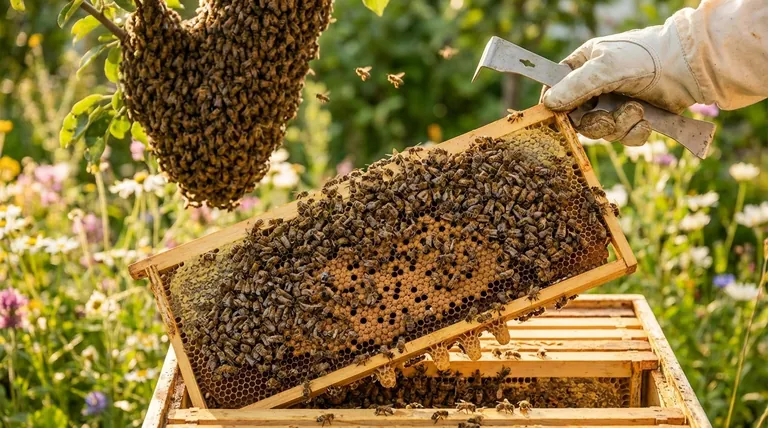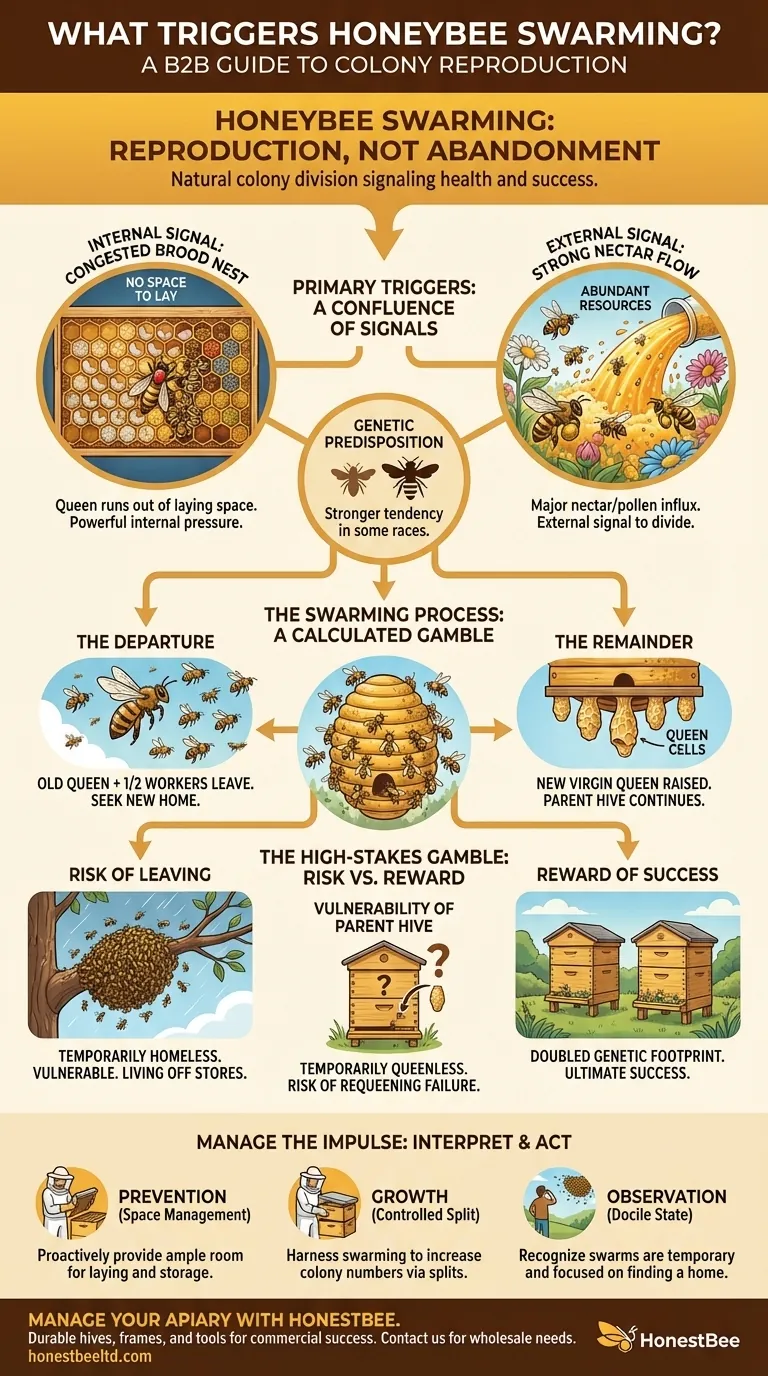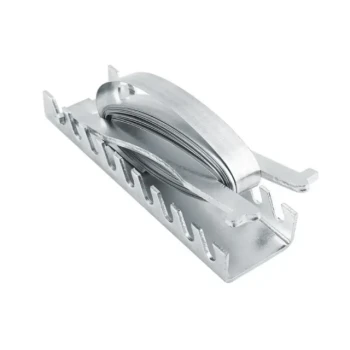At its core, honeybee swarming is triggered by two primary factors. The most significant is an overcrowded nest, where the queen runs out of space to lay eggs. This internal pressure often coincides with a major external signal: the first strong nectar flow of the season, which tells the colony it has the resources to divide.
Swarming should not be viewed as a problem or an abandonment of the hive. It is the honeybee colony's natural and only method of reproduction—a sign that the colony is so healthy and successful that it can afford to split itself in two.

Swarming is Reproduction, Not Abandonment
To truly understand the triggers, we must first recognize the biological purpose of swarming. It is the way the "superorganism" of the colony creates a new daughter colony, ensuring the survival of its genetics.
The Old Queen Departs
A common misconception is that a new queen leads a swarm. In reality, the colony's original, established queen leaves the hive, taking with her roughly half of the worker bees.
A New Queen Remains
Before the old queen leaves, the workers will have prepared several special "queen cells." The colony that remains behind will raise one of these new virgin queens to take over, ensuring the parent hive continues.
The Key Triggers for Swarming
A confluence of internal and external signals must align for a colony to commit to the high-risk act of swarming.
Congestion in the Brood Nest
The brood nest is the heart of the colony, where the queen lays her eggs. When this area becomes full of eggs, larvae, pollen, and honey, the queen has nowhere left to lay. This congestion is a powerful internal signal that the hive has reached its capacity.
The Arrival of a Strong Nectar Flow
A sudden, massive influx of nectar and pollen—known as a nectar flow—is the primary external trigger. This abundance of resources tells the bees that the environment is rich enough to support both the parent colony and a new daughter colony. Swarming peaks during this time.
Genetic Predisposition
Not all honeybees are the same. Some races of honeybees have a much stronger genetic tendency to swarm than others, even in hives that are not severely overcrowded. This is a crucial factor in swarm management.
The High-Stakes Gamble of Swarming
From the colony's perspective, swarming is a high-risk, high-reward strategy for genetic propagation. It is a calculated gamble based on the triggers they perceive.
The Risk of Leaving
The departing swarm is essentially homeless. It must cluster nearby while scout bees search for a suitable new cavity. During this time, the bees are exposed and living off only the honey they carried with them.
The Reward of Success
If the swarm successfully finds a new home and establishes itself, the original colony has effectively doubled its genetic footprint on the landscape. This is the ultimate biological success.
The Vulnerability of the Parent Hive
The original colony is also at risk. It is temporarily queenless and must successfully raise and mate a new queen. If this process fails, the parent colony is doomed.
How to Interpret These Signals
Understanding these triggers allows you to anticipate and manage the swarming impulse, whether you are a beekeeper or simply an interested observer.
- If your primary focus is preventing a swarm in your hive: You must be proactive in managing space, ensuring the queen always has ample room to lay and the bees have space to store honey.
- If your primary focus is growing your number of colonies: You can harness the swarming impulse by performing a "split," which mimics the natural swarm process in a controlled way.
- If you are simply an observer who finds a swarm: Recognize that these bees are in a temporary, docile state and are focused on finding a new home, not on stinging.
By understanding the triggers, we see swarming not as a chaotic event, but as a sign of a thriving colony executing its most fundamental biological imperative.
Summary Table:
| Trigger | Description | Impact on Colony |
|---|---|---|
| Congested Brood Nest | Queen runs out of space to lay eggs. | Powerful internal signal to divide. |
| Strong Nectar Flow | Major influx of nectar and pollen. | External signal of abundant resources. |
| Genetic Predisposition | Some bee races swarm more readily. | Inherent tendency for reproduction. |
Manage your apiary's swarming impulse effectively with the right equipment from HONESTBEE. As a trusted wholesale supplier for commercial apiaries and distributors, we provide the durable beehives, frames, and tools you need to manage colony space and health. Let our expertise and high-quality supplies help you turn the natural swarming process into an opportunity for growth. Contact our team today to discuss your wholesale beekeeping supply needs.
Visual Guide

Related Products
- HONESTBEE Advanced Ergonomic Stainless Steel Hive Tool for Beekeeping
- Full Set Beekeeping Electronic Bee Venom Collector Machine Device for Bee Venom Collecting
- No Grafting Queen Rearing Kit: System for Royal Jelly Production and Queen Rearing
- Thick PVC Material Waterproof Anti-Slip Wear-Resistant Bee Work Shoes Boots for Garden Outdoor Utility
- Plastic Bee Hive Stand for Beekeeping
People Also Ask
- What are the basic tools for beekeeping? Essential Starter Kit for Safe & Successful Hive Management
- What is a hive tool and what are its uses? Master Your Hive Inspections with the Essential Beekeeper's Tool
- What is the hole in a hive tool for? A Multi-Tool for Apiary Repairs and Maintenance
- How is a hive tool used for scraping and cleaning? Master Hive Maintenance for a Healthy Colony
- How should beekeepers handle bees when using a hive tool? Master Calm, Deliberate Techniques



















